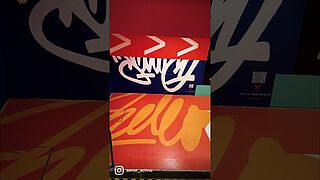Interview mit Philip Wallisfurth
Urban contemporary artist Philip Wallisfurth has been designing walls for 16 years. His repertoire is diverse and ranges from classic paste-ups and moss graffiti to sculptures and paintings on canvas, in styles between comic and abstract. In this interview, he talks us through his life, artworks and current projects.
How did you come to your current profession?
I came to it in a roundabout way. I actually trained as a foreign language correspondent and then tried to train as a hotel manager. At the time, I didn't think it was possible to earn enough from art to make a living. My move to Berlin finally made it possible. It's a big challenge and requires a lot of self-assertion and self-management to make a living from it. But in the end I'm glad I took this difficult path.
What is the preparation phase of a project like? How long does a project take on average?
That varies greatly from project to project. As a rule, a client needs a draft, which usually goes through a few correction loops. After the offer has been accepted, colours are ordered and further planning and details for the project are arranged. This can take from six months to a few days, depending on the project.
What are often the biggest difficulties?
In many companies, finding the motivation is the most work, which has to fit with the company philosophy. I always recommend giving the artist as much freedom as possible, as this achieves the better results in the end. Permits or heritage issues can also cause problems.
What was your biggest/most beautiful project so far?
My biggest project was a 600 square metre subway in my home town of Aachen. I only had 14 days of effective working time, including pre-painting and 12 large walls - that was a tight programme. However, I was able to work freely and I could stay at home, where my old friends visited me every day. Then in 2022, the biggest urban art festival, Peinture Fraiche, was held in Lyon. I created four anamorphic artworks and a mural there within a month. Before, it was a dark, dusty place, but after, it was a bright white gallery space with three-dimensional artworks up to 40 metres long and 11 metres wide.
What has been the biggest challenge so far? Are there moments when you sometimes wish you had a different job?
The daily unknown is the biggest challenge. Controlling, communication and creativity at the push of a button to increase market value. The art scene is special and demands a lot from you especially without a sponsor, patron or rich parents. The freedom in this "profession" is unbeatable, although you never know what will come next month or what will suddenly be cancelled. I love making a living with art and always look forward to new challenges and projects. But I kept thinking how nice it would be to have a "normal" job with fixed working hours.
How does it feel when a work of art is completed?
That can vary. There are artworks where you think, "well, I can do better". But these are usually projects with clear guidelines. With most free projects, the feeling afterwards is great. When it's finished and you're standing in front of it, the pressure falls off you and you can go back to sleep relaxed. Then the project is virtually "ticked off" and a new one can begin.
What would your dream project look like if you could wish for one?
It would definitely be one where I could work freely - perhaps on a well-known central structure or across several buildings (Anamorphosis). Preferably one where the art is not compromised because of budget: A project that makes a place unique and inspires people to use it better.
What do you enjoy most about your work?
The freedom, the variety, the new challenges and the people you meet are all things I value. I also love to travel and the fact that I work for my future and not for a company allows me to be completely myself and luckily make a good living from it.
And of course, we would like to know from you:
What excites you about our colours?
I haven't known KEIM colours for that long and I used them for the first time at a festival to realise a project. There I designed a tar floor and was completely surprised that I could create opaque yellow surfaces without stains with only one coat. I think it's great that attention is paid to sustainability, durability and quality. I wonder why these aspects are not yet pursued so much in urban art. Paints with a mineral origin that not only look good but can also do more, like KEIM's photocatalytic paints, would be a logical step towards making urban art more sustainable and resource-friendly.
What is your favourite KEIM product?
Of course, all the colours sponsored for urban art projects (smiles). It's difficult to choose because KEIMFARBEN only has good products.
His motto as an artist: "The street is the biggest museum in the world and admission is free." (Banksy)
Contact Philip Wallisfurth
Website: Wallisfurth.com
Instagram: @philip_wallisfurth
Telephone: (+49) 015750685290
Mail: info@Wallisfurth.com

